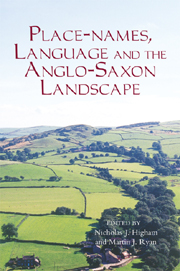Book contents
- Frontmatter
- Contents
- List of Illustrations
- Acknowledgements
- List of Contributors
- Abbreviations
- 1 Place-Names, Language and the Anglo-Saxon Landscape: An Introduction
- 2 The Landscape of Place-Name Studies
- 3 Place-Names as Travellers' Landmarks
- 4 Light thrown by Scandinavian Place-Names on the Anglo-Saxon Landscape
- 5 Language and the Anglo-Saxon Landscape: Towards an Archaeological Interpretation of Place-Names in Wiltshire
- 6 Hunting the Vikings in South Cumbria from Ambleside to Haverbrack
- 7 Viking-Age Amounderness: A Reconsideration
- 8 The Woodland Landscape of Early Medieval England
- 9 The Pre-Conquest Lands and Parish of Crediton Minster, Devon
- 10 Rewriting the Bounds: Pershore's Powick and Leigh
- 11 That ‘Dreary Old Question’: The Hide in Early Anglo-Saxon England
- 12 Boroughs and Socio-Political Reconstruction in Late Anglo-Saxon England
- Index
8 - The Woodland Landscape of Early Medieval England
Published online by Cambridge University Press: 05 February 2013
- Frontmatter
- Contents
- List of Illustrations
- Acknowledgements
- List of Contributors
- Abbreviations
- 1 Place-Names, Language and the Anglo-Saxon Landscape: An Introduction
- 2 The Landscape of Place-Name Studies
- 3 Place-Names as Travellers' Landmarks
- 4 Light thrown by Scandinavian Place-Names on the Anglo-Saxon Landscape
- 5 Language and the Anglo-Saxon Landscape: Towards an Archaeological Interpretation of Place-Names in Wiltshire
- 6 Hunting the Vikings in South Cumbria from Ambleside to Haverbrack
- 7 Viking-Age Amounderness: A Reconsideration
- 8 The Woodland Landscape of Early Medieval England
- 9 The Pre-Conquest Lands and Parish of Crediton Minster, Devon
- 10 Rewriting the Bounds: Pershore's Powick and Leigh
- 11 That ‘Dreary Old Question’: The Hide in Early Anglo-Saxon England
- 12 Boroughs and Socio-Political Reconstruction in Late Anglo-Saxon England
- Index
Summary
One of the greatest changes in the perception of the early landscape and in historical thought on the subject of early medieval woodland, has been in the quantity and nature of the woodland believed to have been present. In the late 1950s, we were presented with an idea that seems to owe more to notions of the American frontier than early medieval England – dense areas of primeval woodland in many regions waiting to be cleared by intrepid Anglo-Saxon colonists. There was even a notion of ‘mother’ villages sending out colonists to construct ‘daughter’ settlements in the wilderness. When W. G. Hoskins published his The Making of the English Landscape in 1955 he followed the then conventional view that at the beginning of medieval times:
Much of England was still thickly wooded, even in districts that had long been settled … From rising ground England must have seemed one great forest before the fifteenth century, an almost unbroken sea of tree-tops with a thin blue spiral of smoke rising here and there at long intervals. Even after twenty generations of hacking at the waste, the frontiers of cultivation were rarely far away from the homesteads.
In the Midland region, the Computer-Mapped Flora of Warwickshire, published in 1971, was placed within a historical setting that still presented this same hypothesis: prehistoric and Romano-British colonists had established themselves along the valley of the River Avon before venturing out southwards and finally northwards into the ‘Forest of Arden’.
- Type
- Chapter
- Information
- Place-names, Language and the Anglo-Saxon Landscape , pp. 143 - 174Publisher: Boydell & BrewerPrint publication year: 2011



